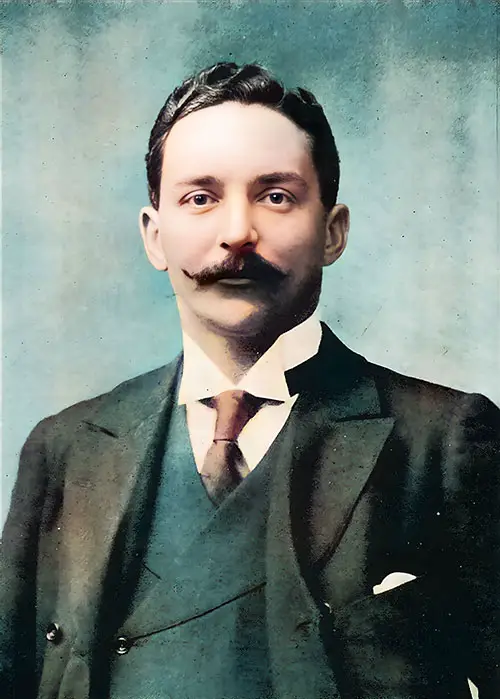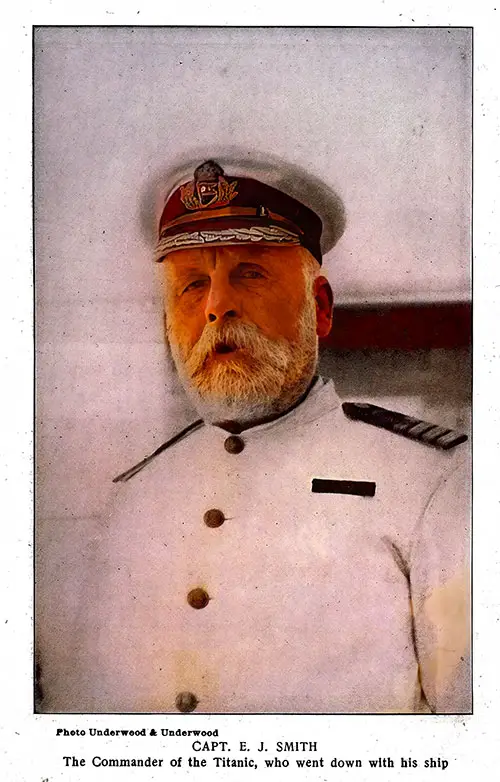Titanic: A Great Tragedy's Warning and Inspiration - 1912

Mr. J. Bruce Ismay, Chairman and Managing Director of the White Star Line. The Shipbuilder (Midsummer 1911) p. 2. GGA Image ID # 10b1ec3dc2
Introduction
The sinking of the RMS Titanic in April 1912 remains one of the most poignant maritime tragedies in modern history, not only for the scale of the loss but also for the profound moral and societal reflections it provoked. Published shortly after the disaster, "Titanic: A Great Tragedy's Warning and Inspiration" in Leslie's Weekly examines the events leading up to the catastrophe, attributing blame across multiple fronts: the White Star Line's relentless pursuit of speed and luxury, the captain's decisions, and the broader societal obsession with records and opulence. Beyond assigning blame, the article elevates the story of the Titanic to a moral parable about the virtues of sacrifice, heroism, and the enduring strength of Christian ideals. It challenges readers to reflect on the balance between progress and safety and the human capacity for both folly and nobility in the face of tragedy.
In its sacrifice of safety to speed and show, the sea's greatest catastrophe reveals a weakness in modern life; in moral heroism, it reveals civilization's most exquisite flower.
We may blame the Titanic's brave captain for running at almost top speed in the region of icebergs, whose presence he had been thrice warned. Perhaps one may find that blame rests, too, on the managing director of the White Star company who was on board the ill-fated "unsinkable" ship.
We may also blame, and rightly, the steamship company which directly or inferentially encourages taking great chances to make record trips. We may hold the company responsible, likewise, for having only about one-third of the necessary lifeboat capacity, absurdly offering to the public unobstructed outlooks and promenades, swimming pools, squash courts, gymnasia, and other luxuries, in place of universal provision for the saving of life.
But, in justice, one should say that the White Star company has not sinned above its sister companies in these regards. In the building of the Titanic, it had scored on its competitors. Still, among all the leading companies, there has been a keen rivalry to possess vessels that spell the last word in size and luxury of appointments and clip hours, or even minutes, from transatlantic records.

Captain E. J. Smith, Commander of the Titanic, Went Down With His Ship. © Underwood & Underwood. Wreck and Sinking of the Titanic (1912) p. 00-c. GGA Image ID # 1102b58573
Captain E. J. Smith, Commander of the Titanic, Went Down With His Ship. © Underwood & Underwood. Wreck and Sinking of the Titanic (1912) p. 00-c. GGA Image ID # 1102b58573
Yes, captains and steamship companies are responsible. But there is a third party to the case. And that is our speed-mad and luxury-loving age, which has demanded this sort of thing, and when the risk has been carried through with success, it has loudly applauded.
Time and again in our country, similar warnings have come to us when, in railroad wrecks, the same demand for records has thrown safety to the breeze, entailing the sacrifice of a dozen or score of lives.
At what awful price has the tragedy of the sea taught the world that human cargoes are more sacred than luxurious vessels and record-breaking voyages.
The steamship companies have already agreed to a new "long" course farther south. Other reforms regarding sufficient lifeboats, speed, and luxury limitations will follow.
Turning to the sinking of the great ship, we have a picture that is heartrending and infinitely sad. It is also a tale of voluntary renunciation and sacrifice, making an immortal contribution to humanity's ideals.
No scene of martyrdom in the arena of long ago ever presented human nature in a nobler aspect than that shown as the Titanic's captain called out, "Women and children first!" in the main, every man on board, millionaire, and stoker, first cabin and steerage, answering the call.
Whence came to this strange rule of the sea? No law prescribes it. No proud civilization of the past gave it birth. Even in many cultures today, the authoritarian rule is "Men first, children next, women last."
Other religions and civilizations may not entirely lack ideal suggestions. Still, the Christian faith and society inspire vicarious sacrifice, teaching that "the strong ought to bear the infirmities of the weak."
The evolutionary hypothesis has been much modified since Darwin explained the history of the race by the "survival of the fittest." However, for many, the phrase still epitomizes their philosophy of life.
The Christian Gospel has never been so taught. And it takes a tragedy like this to show how great our age, universally decried as sordid and material, is permeated with Christianity's sacrificial ideals.
The common element in human life gives character its most valuable content. Everyone who went down with the ship died so that someone else might be saved. The Carpathia might have come back with a boatload of men, with stories of women beaten and pushed from lifeboats, rafts, and children left on the foundering vessel.
Then would we have hung our heads in shame? But survivors tell a story of most exceptional heroism on the part of men and women as well—a tale that will make an immortal chapter in the literature of our common humanity and add precious treasure to the ideals of the race.
"A Great Tragedy's Warning and Inspiration," in Leslie's Weekly, Vol. CXIV, No. 2956, 2 May 1912, p. 503.
Key Points
-
Critique of the Pursuit of Speed and Luxury:
- The article criticizes the White Star Line and other steamship companies for prioritizing speed, luxury, and record-breaking over passenger safety. It highlights the lack of adequate lifeboats and other safety measures on the Titanic, which were sacrificed for amenities like swimming pools, squash courts, and unobstructed promenades.
- This critique extends to Captain Edward J. Smith, who, despite receiving iceberg warnings, continued at near full speed, contributing to the disaster.
-
Societal Responsibility and the "Speed-Mad Age":
- The article suggests that the blame is not solely on the steamship companies and their captains but also on society, which demanded and celebrated these reckless endeavors. The "speed-mad and luxury-loving age" is held accountable for encouraging a culture that valued spectacle over safety.
- This cultural obsession with breaking records and showcasing grandeur is paralleled with similar incidents in railroads, where safety is compromised for the sake of speed.
-
Reform and Future Precautions:
- In the wake of the Titanic disaster, immediate changes were implemented, such as the introduction of a "longer" transatlantic route further south to avoid icebergs. The article predicts that additional reforms will follow, including the implementation of stricter regulations for lifeboat capacity, speed limits, and luxury limitations.
-
Moral Heroism and the Rule of Sacrifice:
- Amid the tragedy, the article emphasizes the heroism displayed by the Titanic's crew and passengers. The "Women and children first" rule, followed by men from all classes and backgrounds, is portrayed as a testament to moral heroism and self-sacrifice.
- The article contrasts this behavior with other cultures and historical precedents, suggesting that such actions are deeply rooted in Christian values and teachings that emphasize the strong sacrificing for the weak.
-
Christian Ideals and Sacrificial Ethics:
- The author reflects on how the Christian gospel has shaped the ethics of sacrifice, contrasting it with Darwin's "survival of the fittest." The tragedy is framed as a demonstration of these Christian ideals, showing that even in an age often criticized for its materialism, the values of selflessness and sacrifice remain potent.
-
Legacy of Heroism and Human Ideals:
- The survivors' accounts highlight exceptional heroism by both men and women, a narrative that is lauded as adding an "immortal chapter" to human history and enriching the moral ideals of humanity. The article argues that, had the survivors' stories been different, society would have faced a profound moral reckoning.
Summary
The article "Titanic: A Great Tragedy's Warning and Inspiration" serves as both a critique and a reflection on the societal and moral implications of the Titanic disaster. It condemns the prioritization of speed and luxury by steamship companies and critiques the societal obsession with grandeur and record-setting that underpinned such decisions. The piece calls for reforms in maritime safety, such as increased lifeboat capacity and safer shipping routes. More importantly, it highlights the profound heroism demonstrated by the Titanic's passengers and crew, who adhered to a code of sacrificial ethics rooted in Christian values. This narrative of selflessness, where men willingly gave up their lives for women and children, is celebrated as an enduring testament to the strength of these ideals in an era often accused of materialism.
Conclusion
The Titanic disaster remains etched in history not only for the magnitude of its loss but also for the enduring lessons it imparts about human nature, values, and priorities. "Titanic: A Great Tragedy's Warning and Inspiration" captures these lessons, using the tragedy as both a stark warning against the dangers of unchecked ambition and a profound illustration of moral heroism. It challenges society to remember that technological progress and luxury must never come at the expense of human life. Moreover, it reaffirms the timeless value of self-sacrifice and ethical conduct, deeply rooted in Christian teachings, which shines through even in the darkest of moments. As we reflect on the Titanic's legacy, we are reminded of the need to balance innovation with caution and celebrate the inherent goodness and bravery that can emerge in times of crisis.
